In the heart of Moffett Field, California, where the historic hangar doors creak with the weight of aviation history, Pathfinder 1, a cutting-edge modern airship is taking shape at LTA Research (LTA)—an aerospace R&D company backed by Google cofounder Sergey Brin. This diverse team is dedicated to advancing airship technology with a clear mission: to expand and complement humanitarian relief in disaster areas and pave the way for clean transportation.
On November 8th, Pathfinder 1, the largest aircraft built since the 1930s emerged from its WW2-era Hangar Two at NASA’s Moffett Field, ready for some outdoor evaluation. It was guided by ropes held by a large team of engineers, technicians, and ground crew. Then it was rolled back in. The white, sleek, rigid airship with an elongated hull, reminiscent of the iconic airships of the past and with a gondola-like cabin suspended below, stretches an impressive 400 feet in length and 66 feet at its widest. Pathfinder 1 is a test airship that combines old-fashioned design, new materials, and advanced engineering. This prototype, if successful, will bring a new generation of larger airships to flight.
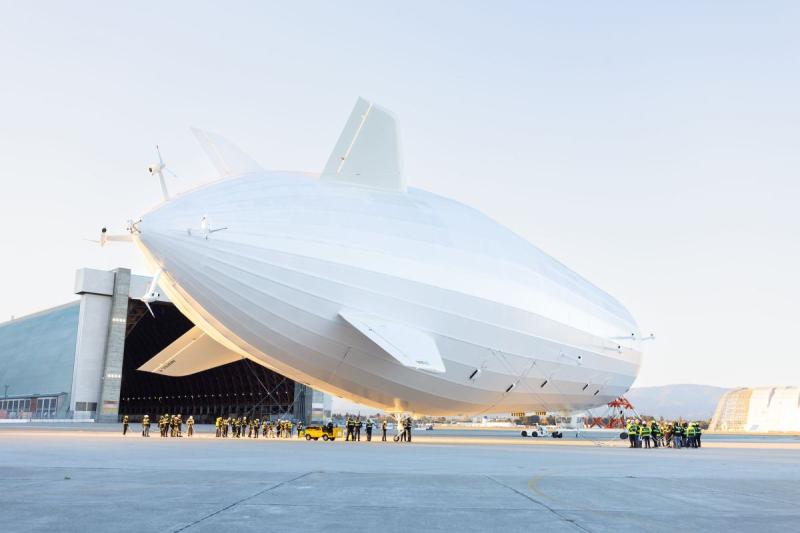
Photo Credit LTA Research
The testing unfolded as expected. The initial objective was to understand how the experimental airship with its one million cubic feet of helium and weather-resistant polymer skin, would react to the heating impact of California’s sunlight. When the sun warmed its skin, the airship superheated, expanded, and got lighter. Powered by small electric motors, it smoothly moved in different directions. “It performed really well,” LTA CEO Alan Weston told Mercury News. Weston is a veteran in the aerospace field and has a passion for pushing boundaries.In the 1970s, he pursued engineering at the University of Oxford. His career unfolded at the US Air Force, contributing to the strategic defense initiative, commonly known as Star Wars. Weston joined NASA Ames Research Center in 2006 and led over 50 missions, including the development of a low-cost lunar lander. At the Ames Research Center, Weston and Brin developed a professional acquaintance, finding common ground in their shared interest in airship technology.
Modern transportation often leaves a significant carbon footprint, with the aviation industry alone emitting nearly 1 billion metric tons of carbon dioxide (CO2) annually. At LTA, the focus is on constructing airships that are not only safer and stronger but also environmentally efficient. LTA envisions a future where zero-emission airships play a pivotal role in supporting and expediting disaster response and relief efforts. These airships can land and take off vertically, even when runways, roads, and ports are damaged, delivering vital supplies to communities in need. If cellphone towers are knocked out, these airships can hover above and provide much-needed communication services.
“It’s been 10 years of blood, sweat and tears,” Weston told TechCrunch on the eve of the unveiling. “Now we must show that this can reliably fly in real-world conditions. And we’re going to do that.”
The initial stages of testing will involve tethered flights to ensure the airship’s readiness. Subsequently, Pathfinder 1 will fly several FAA-approved missions within a restricted zone, not exceeding 1,500 feet over the south side of the San Francisco Bay area, where it won’t interfere with any regular air traffic.
Currently, LTA’s certified airship pilots, flight test engineers, and seasoned ground crew are engaged in rigorous testing and training, preparing for an upcoming extended outdoor flight. Acknowledging the vital role of the ground crew, their skill in guiding the airship in and out of the hangar, and during take-off and landing is deemed as important as the expertise of certified airship pilots.
The Birth and Resurgence of Airships
In the realm of aviation, the first aircraft invented were hot air balloons and gas balloons in 1783 in France. Now, when we talk about lighter-than-air aviation (basically, things that float in the air), there are two main types of aircraft: balloons and airships. Both rise and float due to buoyancy, meaning their total weight is less than the air they displace.
Balloons, both in the past and present, lack engines, but pilots can make them go up or down by changing the amount of gas or hot air inside the balloon. Though they cannot steer it like a car, skilled pilots can control their course and height by riding different air currents at different altitudes.
Since balloons are not navigable, the 19th century saw continued attempts to add methods of propulsion to balloons. Henri Giffard, a visionary French engineer, crafted the first navigable airship in 1852, propelling it forward with a steam-powered engine. However, practical airships only became a reality with the introduction of the gasoline engine in 1896. Alberto Santos-Dumont continued this legacy in 1898 by developing a gasoline-powered airship. Thus, entered the airship, a powered LTA craft born from the fusion of elongated balloons and engines.

Airships evolved into three forms: the nonrigid blimp, the semirigid vessel offering improved stability, and the rigid giant known as the Zeppelin. The non-rigid blimps rely on the pressure of the gas within, such as helium or hydrogen to maintain their form. On the other hand, semirigid airships introduce a subtle framework, providing some structural support, while rigid airships (aka Zeppelins) have a full rigid structure to ensure steadfast stability.
Typically, as seen with many innovations, the military swiftly identified practical applications for both the balloon and the airship. In the early 20th century, among various countries engaged in airship construction, the United States stood out as the primary producer of these innovative aerial vehicles. Airships played a role in World War I for military reconnaissance and even bombing missions. Certain massive U.S. Navy airships had the capacity to transport a fleet of biplanes and refuel them using a hook system.
Once the war ended, airships found commercial success, becoming symbols of luxury travel. They were the marvels of the sky and were at the height of travel innovation in the 1920s and 1930s, offering an exhilarating way for sightseeing and traveling over long distances. In fact, the world’s first airline DELAG established in Germany in 1909, pioneered a new era in airship travel. The company offered the world’s first transatlantic passenger airline service, using LZ-127 Graf Zeppelin, which completed an impressive 143 Atlantic crossings before being retired after the Hindenburg disaster in 1937.
The golden era of airships declined in the 1930s, due to the rise of airplanes and some tragic disasters such as the storm-related losses of the helium-filled airships USS Macon and USS Akron, and the explosive incident involving the hydrogen-filled airship, the Hindenburg.
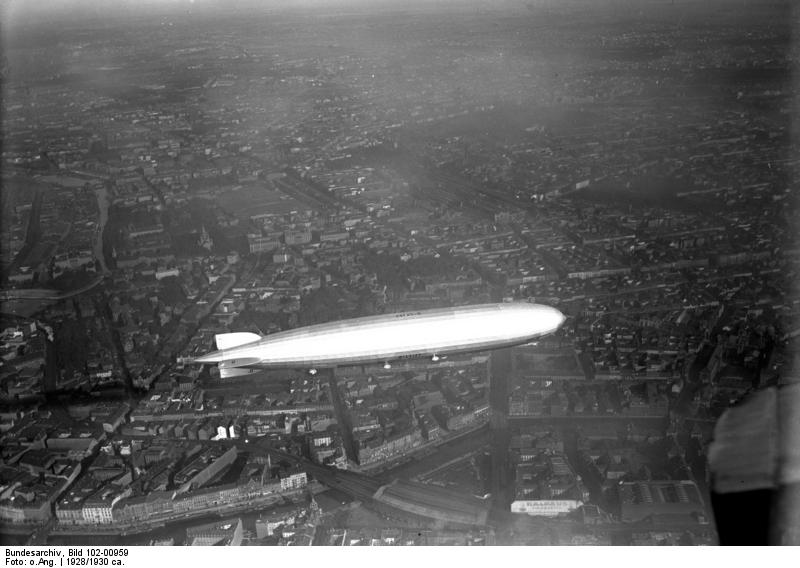
Today, few companies remain in the airship business. The iconic Goodyear blimps, a remnant of a bygone era, still grace the skies during major events, serving as a floating billboard for advertising.
The last airship was built by the Navy in 1960, in the Akron Airdock. By this time, airships were no longer employed for passenger or cargo transport and their use in the military also decreased. However, the past 20 years has seen a resurgence of interest in airships, with various projects and innovations emerging globally.
In 2006, the U.S. Navy resumed airship flights, after a 44-year hiatus. In 2010, the U.S. Army awarded a $517 million contract to Northrop Grumman and UK’s Hybrid Air Vehicles (HAV) for a Long Endurance Multi-Intelligence Vehicle (LEMV) system, but the program was scrapped for lack of funds and HAV bought the rights to the project. After years of research and development, Airlander 10, the hybrid airship, went through a complete transformation, and it is being tested for the commercial market.
Pathfinder 1
Alan Weston began researching airships in the archives in Akron, in 2014, and engaging with airship designers, including the German manufacturer Luftschiffbau Zeppelin GmbH and the American multinational Goodyear Tire and Rubber Company. Subsequently, LTA established facilities in Akron, Ohio; Gardnerville, Nevada; and Moffett Field, California, generating new jobs in these regions. In 2022, LTA became the official owner of the Akron Airdock, and a year later after months of pre-flight training and tests, Pathfinder 1 progressed to its inaugural indoor flight in Mountain View, CA, which led to its outdoor testing on November 8th.
From construction to pilot training, Pathfinder 1 surpasses early 20th-century airships in being lighter, safer, and more capable. Notably, its safety is enhanced by utilizing helium, a non-flammable lifting gas.
The airship’s impressive design features a strong yet light carbon fiber skeleton and a nonflammable outer layer made of lightweight Tedlar. This construction ensures sturdiness, UV resistance, and the ability to block visible light.
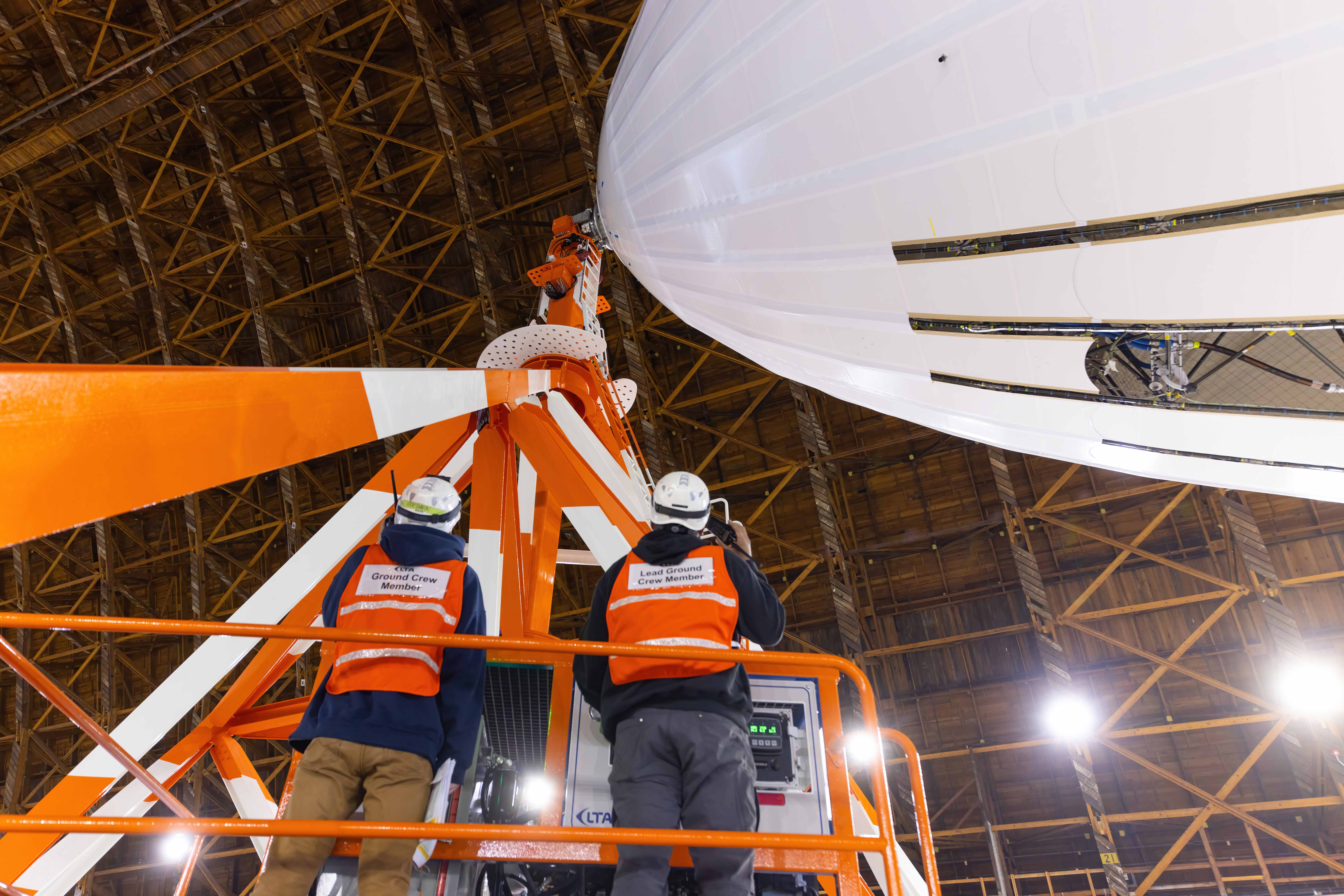
Photo Credit LTA Research
Pathfinder 1’s propulsion, powered by a dozen electric motors, along its sides and tail, promises speeds of up to 75 mph with precise control. Two generators (150-kilowatt) distribute power to the electric motors integrated into the airframe.
Solar panels and ongoing research into hydrogen fuel cells hint at a future where these airships are not just clean but also self-sustainable.
The nose cone of Pathfinder 1 has been crafted in partnership with Zeppelin. It’s a mix of titanium dock, aluminum adapter, Kevlar shield, and carbon fiber. This cone doesn’t just moor the airship gently; it can withstand winds up to 80 mph.
Controlled by a fly-by-wire system, Pathfinder 1 responds to joystick commands from pilots in the Zeppelin-built gondola with sensor feedback data to actuate the 12 electric motors and four fin rudders to fly the airship.
The airship’s main frames are like a skeleton. Welded titanium hubs and carbon fiber tubes form a circular rib cage, and reinforced joints in critical areas make sure Pathfinder 1 stays tough and safe even when it’s carrying significant loads for humanitarian missions.
The interior of the ship has 13 sections, each with a helium cell made from ripstop nylon-based fabric and monitored by Lidar sensors. The company’s website says, “At LTA Research, we treat helium like the precious resource that it is and keep our helium footprint small by containing and recycling it. We are always looking for new ways to increase our efficiency.”
The gondola is designed to accommodate up to 14 people, with a single-pilot operation setup, complete with dual controls for flight testing.
The team also came up with significant breakthroughs in the assembly of Pathfinder 1. Unlike the precarious methods of the past, where workers climbed towering scaffolding, LTA introduced a rotisserie system. The entire airship skeleton rotates, allowing workers to operate mostly at ground level, ensuring both safety and a ten-fold increase in manufacturing efficiency.
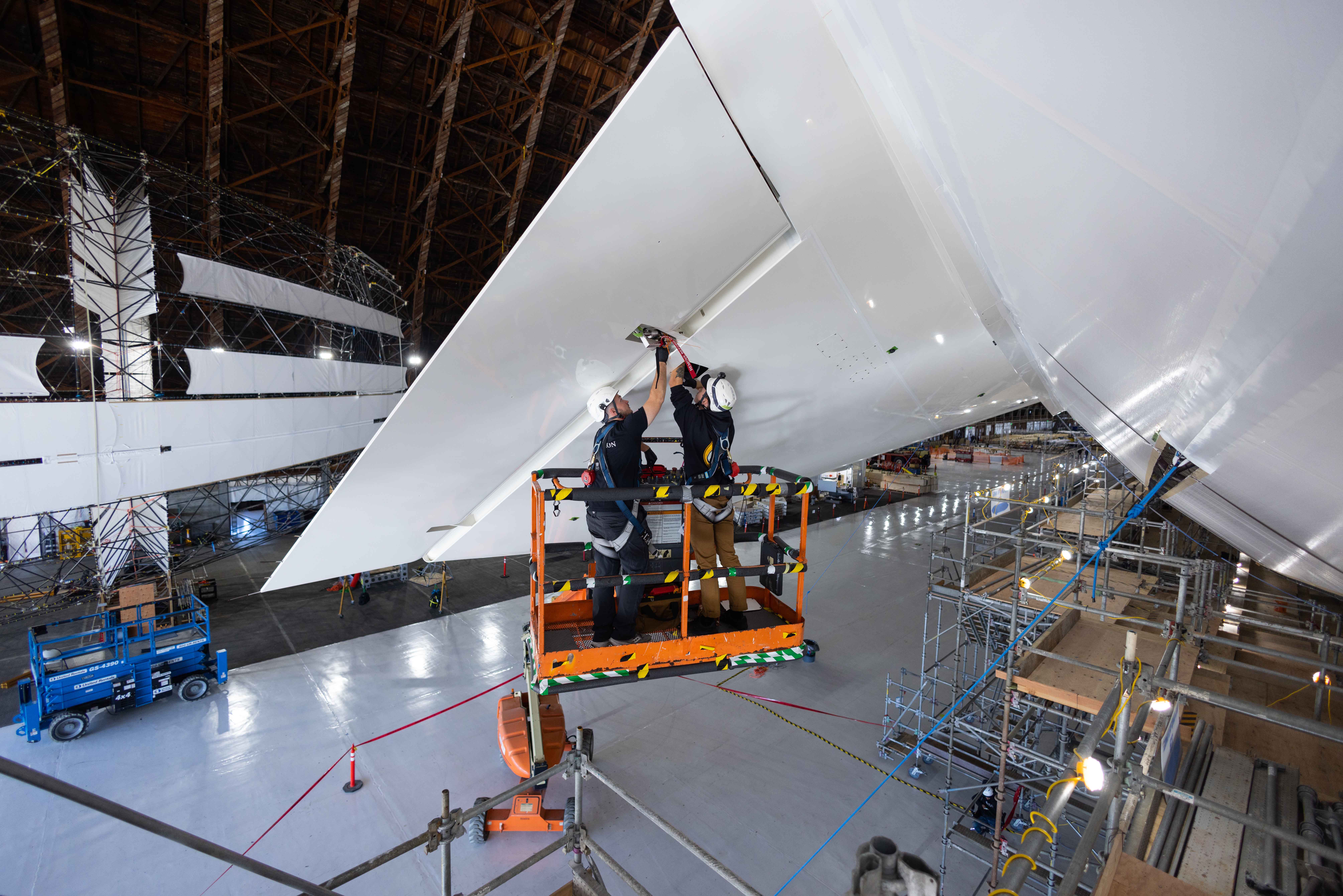
Anticipated to transport payloads ranging from 4,400 pounds (2,000 kg) to 11,000 pounds (5,000 kg), Pathfinder 1 has a versatile capacity depending on the airship’s final weight and the nature of each mission. Following the success of this prototype, LTA plans to build much bigger airships with greater cargo capacity in the coming years. The potential of these airships to access remote and disaster-affected areas and transport substantial cargo, holds promise for making a significant impact in saving lives and delivering crucial relief supplies.
However, the airship industry faces several challenges, as is seen in the ambitious undertaking by Flying Whales, a French company dedicated to developing heavy-lift airships for transporting cargo, especially within the forestry industry. Overcoming technical hurdles in loading, unloading, or executing a cargo-ballast swap proves to be a significant challenge. As heavy cargo is unloaded, making the airship lighter and causing it to ascend much higher, it becomes imperative to carefully balance buoyancy and weight. While some solutions appear straightforward in theory, maintaining this equilibrium in a dynamic timeframe proves challenging. Among the available options, adding and releasing large quantities of helium during each flight is economically unfeasible. Modifying the airship’s lift during flight requires extensive research and development. One potential solution entails carrying an equal weight of water as ballast and dispensing it as the airship lifts heavy cargo, but this approach also has some practical challenges.
Additionally, inclement weather conditions, such as thunderstorms or high winds, may lead to the grounding of airships for safety reasons. While modern airship designs incorporate advanced technology and control systems to enhance stability, pilots still need to consider and navigate through changing weather patterns.
However, with technological advancements in manufacturing, Weston and Brin seem optimistic and Weston envisions a fleet of airships darkening the skies. These airships, with their ability to hover for hours without burning fuel, could fill critical gaps in transportation, particularly in disaster relief and humanitarian missions.
In the hangar, the whispers of Brin’s financial commitment reach $250 million. According to the Bloomberg Billionaires Index, Brin, with an estimated net worth of $105 billion, also funds a disaster charity called Global Support and Development that provides rapid response aid after volcanic eruptions, earthquakes, and storms.
With companies like Hybrid Air Vehicles, Lockheed Martin, Aeros, VariaLift Airships, OceanSky Cruises, Flying Whales, LTA Research and others actively contributing to the narrative of airship resurgence, the once-forgotten giants of the sky may well reclaim their place in aviation history.
Top featured image: Pathfinder 1 tethered to concrete ballast blocks inside Hangar 2 at Moffett Field in preparation for pre-flight testing. Photo Credit LTA Research
###
Sitara Maruf
Sitara@ltaflightmagazine.com






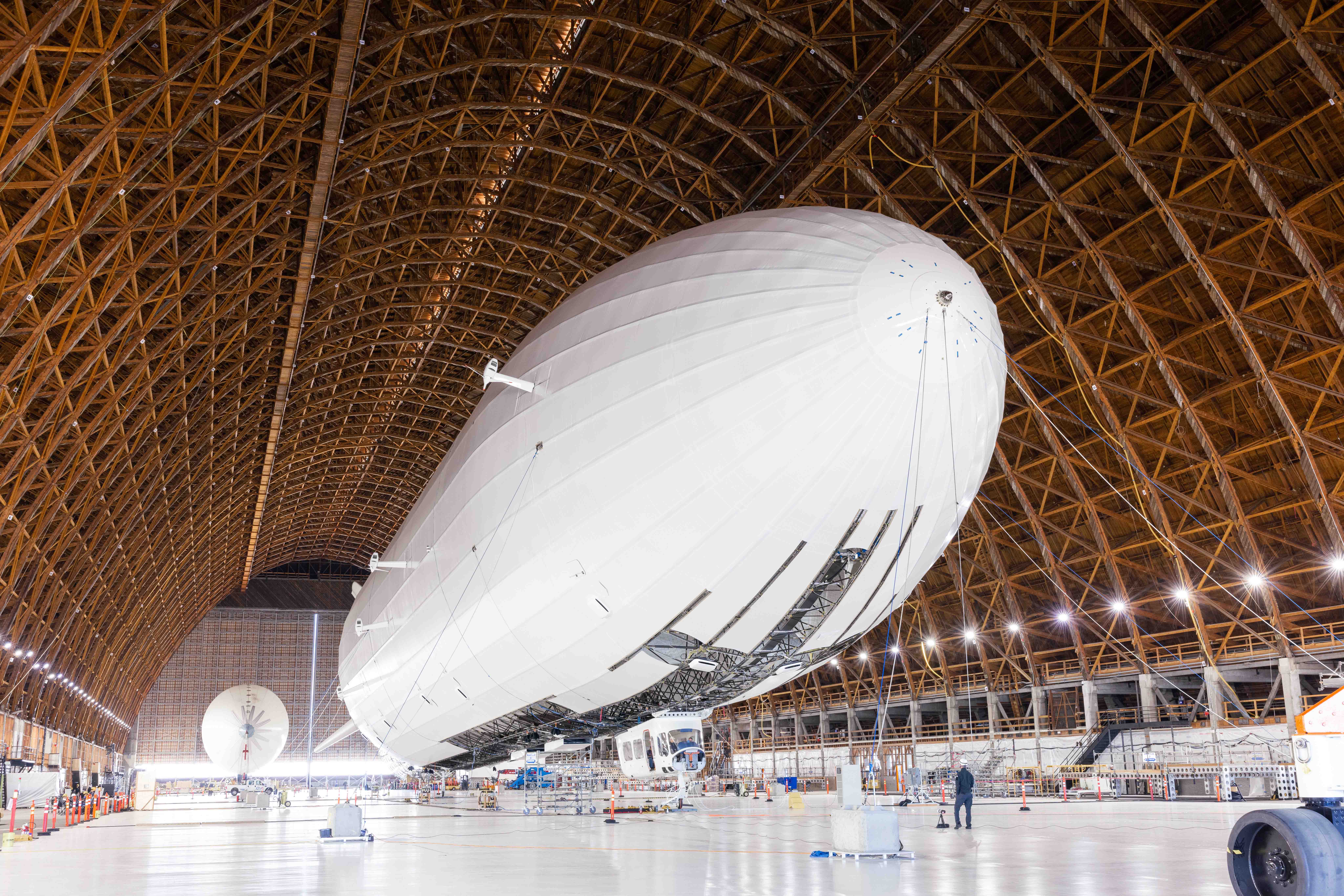
Warm salutations to our friends and esteemed co-partners.
We extend a warm welcome to you in our dynamic company, where quality and reliability are our guiding principles. We are ready to deliver our products and services, adhering to the highest standards, to every corner of the globe.
Our commitment to excellence has led us to successful collaborations in various business sectors. We stand prepared to support you by providing innovative and dependable solutions across diverse industries.
We look forward to having you as part of our network, where each domain becomes an integral aspect of our mutually beneficial collaboration.
company website: https://global.kao-azot.com/
Best regards,
Ivanov Dmitry